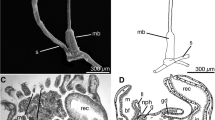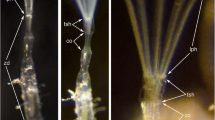Summary
The osphradium of Planorbarius consists of a blindly-ending ciliated canal, formed by an infolding of the mantle epithelium, and a basal ganglion of nerve cells which is comparable in complexity with ganglia of the central nervous system. The distribution of cell types in the osphradial epithelium is specialised so that three regions can be recognised; the ciliated, the secretory and the sensory regions. The basal sensory region of the canal epithelium consists of ciliated cells and is innervated by sensory neurones of the osphradial ganglion. The middle secretory region contains mainly of mucus-secreting cells and the epithelium adjacent to the osphradial aperture of ciliated cells and secretory cells of a second type. The sensory neurones of the osphradial ganglion are bipolar or of a modified monopolar type. Other monopolar neurones, similar to those common in the central nervous system are of non-sensory function. The osphradium of Paludina, although of typical prosobranch form, possesses ciliated pits similar to the single canal of Planorbarius, which may indicate a shared modality of receptor function. A definite function cannot be ascribed to the pulmonate osphradium based on morphological evidence alone.
Similar content being viewed by others
References
Bailey, D. F., Benjamin, P. R.: Anatomical and electrophysiological studies on the gastropod osphradium. Symp. zool. Soc. Lond. 23, 263–268 (1968).
—, Laverack, M. S.: Central nervous response to chemical stimulation of a gastropod osphradium. Nature (Lond.) 200, 1122–1123 (1963).
—: Aspects of the neurophysiology of Buccinum undatum L. (Gastropoda). I. Central responses to stimulation of the osphradium. J. exp. Biol. 44, 131–148 (1966).
Benjamin, P. R.: Studies on the sensory systems of certain freshwater pulmonate molluscs. Thesis for Doctor of Philosophy, University of Durham, U.K. (1968).
—, Peat, A.: A secretory role for the lipid bodies of molluscan neurones. J. comp. Neurol. 132, 617–630 (1968).
- - On the structure of the pulmonate osphradium. II. Ultrastructure. Z. Zellforsch. in press (1971).
Blest, A. D.: Some modifications of Holme's silver method for insect central nervous systems. Quart. J. micr. Sci. 102, 413–417 (1961).
Boer, H. H.: A cytological and cytochemical study of neurosecretory cells in Basommatophora, with particular reference to Lymnaea stagnalis L. Arch. néerl. Zool. 16, 313–386 (1965).
Brown, A. C., Noble, R. G.: Function of the osphradium in Bullia (Gastropoda). Nature (Lond.) 188, 1045 (1960).
Bullock, T. H.: On the anatomy of giant neurons of the visceral ganglion of Aplysia. In: Nervous inhibition (ed. E. Florey). Oxford: Pergamon Press 1961.
—, Horridge, G. A.: Structure and function in the nervous systems of invertebrates. San Francisco: W. H. Freeman 1965.
Burke, W. R.: Chemoreception by Tegula funebralis (Mollusca). Veliger 6, Suppl. 17–20 (1964).
Coggeshall, R. E., Fawcett, D. W.: The fine structure of the central nervous system of the leech, Hirudo medicinalis. J. Neurophysiol. 27, 229–289 (1964).
Copeland, M.: The olfactory reactions and organs of the marine snails Alectrion obseleta (Say) and Busycon caniculatum (Linn.). J. exp. Zool. 25, 177–227 (1918).
Dakin, W. J.: Buccinum. L.M.B.C. Memoirs 20, Lond. (1912).
Demal, J.: Essai d'histologie comparée des organes chémorécepteurs des Gastéropodes. Mem. Acad. roy. Belg. 29, 5–82 (1955).
Gabe, M.: Neurosecretion. Oxford: Pergamon Press 1966.
Hulbert, G. C. E. B., Yonge, C. M.: A possible function of the osphradium in the Gastropoda. Nature (Lond.) 139, 840 (1937).
Jahan-Parwar, B., Smith, M., Baumgarten, R. von: Activation of neurosecretory cells in Aplysia by osphradial stimulation. Amer. J. Physiol. 216, 1246–1257 (1969).
Koln, A. J.: Chemoreception in gastropod molluscs. Amer. Zoologist 1, 291–308 (1961).
Lacaze-Duthiers, H.: Du système nerveux des mollusques gastéropodes pulmonés aquatiques et d'un nouvel organe d'innervation. Arch. Zool. exp. gén. 1, 97–168 (1872).
Michelson, E. H.: Chemoreception in the snail Australorbis glabratus. Amer. J. trop. Med. Hyg. 9, 480–487 (1960).
Simpson, L., Bern, H. A., Nishioka, R. S.: Survey of evidence for neurosecretion in gastropod molluscs. Amer. Zoologist 6, 123–138 (1966).
Stinnacre, J., Tauc, L.: Effets de l'activation osmotique de l'osphradium sur les neurones du système nerveux central de l'Aplysie. J. Physiol. (Paris) 58, 266–267 (1966).
Welsch, U., Storch, V.: Über das Osphradium der prosobranchen Schnecken Buccinum undatum L. und Neptunea antiqua (L.) Z. Zellforsch. 95, 317–330 (1969).
Wölper, C.: Das Osphradium der Paludina. Z. vergl. Physiol. 32, 273–285 (1950).
Yonge, C. M.: The pallial organs in the aspidibranch Gastropoda and their evolution throughout the Mollusca. Phil. Trans. B 232, 443–518 (1947).
Author information
Authors and Affiliations
Rights and permissions
About this article
Cite this article
Benjamin, P.R. On the structure of the pulmonate osphradium. Z. Zellforsch. 117, 485–501 (1971). https://doi.org/10.1007/BF00330710
Received:
Issue Date:
DOI: https://doi.org/10.1007/BF00330710




